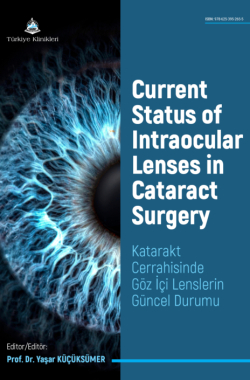Current Biometric Formulations for Modern Intraocular Lenses
Alper AĞCAa , Fahri Onur AYDINb
aDünyagöz Ataköy Hospital, Clinic of Ophthalmology, İstanbul, Türkiye
bUniversity of Health Sciences Faculty of Medicine, İstanbul Başakşehir Çam and Sakura City Hospital, Department of Ophthalmology, İstanbul, Türkiye
Ağca A, Aydın FO. Current biometric formulations for modern intraocular lenses. In: Küçüksümer Y, ed. Current Status of Intraocular Lenses in Cataract Surgery. 1st ed. Ankara: Türkiye Klinikleri; 2024. p.7-11.
ABSTRACT
Cataract surgery is one of the most performed surgeries in the world. With the developing intraocular lens (IOL) technology, patient expectations have similarly increased. Although good results can be achieved in normal eyes with the frequently used 3rd and 4th generation formulas, the success rates are lower in abnormal eyes. For this reason, the search for a better IOL calculation formula continues. Artificial intelligence, which has begun to be used in all areas of life, has also been integrated into the IOL power calculation. In this way, it is expected to achieve increasing success rates over the years.
Keywords: Lenses, intraocular; biometry; intraocular lens power calculation; formulas; artificial intelligence
Kaynak Göster
Referanslar
- Kothari SS, Reddy JC. Recent developments in the intraocular lens formulae: An update. In: Seminars in Ophthalmology. Taylor & Francis; 2023. pp.143-50. [Crossref] [PubMed]
- Xia T, Martinez CE, Tsai LM. Update on Intraocular Lens Formulas and Calculations. Asia Pac J Ophthalmol (Phila). 2020;9(3):186-93. [Crossref] [PubMed] [PMC]
- Barrett GD. Intraocular lens calculation formulas for new intraocular lens implants. J Cataract Refract Surg. 1987;13:389-96. [Crossref] [PubMed]
- Barrett GD. An improved universal theoretical formula for intraocular lens power prediction. J Cataract Refract Surg. 1993;19:713-20. [Crossref] [PubMed]
- Kane JX, Van Heerden A, Atik A, et al. Intraocular lens power formula accuracy: comparison of 7 formulas. J Cataract Refract Surg. 2016;42:1490-500. [Crossref] [PubMed]
- Hoffer KJ, Savini G. IOL power calculation in short and long eyes. Asia Pac J Ophthalmol (Phila). 2017;6:330-1.
- Carmona-González D, Castillo-Gómez A, Palomino-Bautista C, et al. Comparison of the accuracy of 11 intraocular lens power calculation formulas. Eur J Ophthalmol. 2021;31:2370-6. [Crossref] [PubMed]
- Voytsekhivskyy OV, Tutchenko L, Hipólito-Fernandes D. Comparison of the Barrett Universal II, Kane and VRF-G formulas with existing intraocular lens calculation formulas in eyes with short axial lengths. Eye. 2023;37:120-6. [Crossref] [PubMed] [PMC]
- Kane JX, Melles RB. Intraocular lens formula comparison in axial hyperopia with a high-power intraocular lens of 30 or more diopters. J Cataract Refract Surg. 2020;46:1236-9. [Crossref] [PubMed]
- Lin L, Xu M, Mo E, et al. Accuracy of newer generation IOL power calculation formulas in eyes with high axial myopia. J Refract Surg. 2021; 37:754-8. [Crossref] [PubMed]
- Kane JX, Connell B. A comparison of the accuracy of 6 modern toric intraocular lens formulas. Ophthalmology. 2020;127:1472-86. [Crossref] [PubMed]
- Kane JX, Connell B, Yip H, et al. Accuracy of intraocular lens power formulas modified for patients with keratoconus. Ophthalmology. 2020;127:1037-42. [Crossref] [PubMed]
- Olsen T, Hoffmann P. C constant: new concept for ray tracing-assisted intraocular lens power calculation. J Cataract Refract Surg. 2014;40:764-73. [Crossref] [PubMed]
- Olsen T. System and method for determining and predicting IOL power in situ. Google Patents. 2014.
- Debellemanière G, Dubois M, Gauvin M, et al. The PEARL-DGS formula: the development of an open-source machine learning-based thick IOL calculation formula. Am J Ophthalmol. 2021;232:58-69. [Crossref] [PubMed]
- Næser K, Savini G. Accuracy of thick-lens intraocular lens power calculation based on cutting-card or calculated data for lens architecture. J Cataract Refract Surg. 2019;45:1422-9. [Crossref] [PubMed]
- Hipólito-Fernandes D, Elisa Luís M, Gil P, et al. VRF-G, a new intraocular lens power calculation formula: a 13-formulas comparison study. Clin Ophthalmol. 2020:4395-402. [Crossref] [PubMed] [PMC]
- Ladas JG, Siddiqui AA, Devgan U, et al. A 3-D "super surface" combining modern intraocular lens formulas to generate a "super formula" and maximize accuracy. JAMA ophthalmology. 2015;133:1431-6. [Crossref] [PubMed]
- Voytsekhivskyy OV, Hoffer KJ, Savini G, et al. Clinical accuracy of 18 IOL power formulas in 241 short eyes. Curr Eye Res. 2021;46:1832-43. [Crossref] [PubMed]
- Sheard RM, Smith GT, Cooke DL. Improving the prediction accuracy of the SRK/T formula: the T2 formula. J Cataract Refract Surg. 2010;36:1829-34. [Crossref] [PubMed]
- Melles RB, Kane JX, Olsen T, et al. Update on intraocular lens calculation formulas. Ophthalmology. 2019;126:1334-5. [Crossref] [PubMed]
- Darcy K, Gunn D, Tavassoli S, et al. Assessment of the accuracy of new and updated intraocular lens power calculation formulas in 10 930 eyes from the UK National Health Service. J Cataract Refract Surg. 2020; 46:2-7.
- Taroni L, Hoffer KJ, Barboni P, et al. Outcomes of IOL power calculation using measurements by a rotating Scheimpflug camera combined with partial coherence interferometry. J Cataract Refract Surg. 2020;46: 1618-23. [Crossref] [PubMed]

